
History of Antalya
History
‘’Antalya’’ is an eye-catching city discovered with great enthusiasm by the King of Pergamum ’’Attalos II’’ ordering his raiders to “Go find me the heaven of the earth”.
Antalya's roots run deep, with traces of ancient civilizations dating back thousands of years. As you explore the city's historical sites, you'll uncover the legacies of the Romans, Greeks, and Byzantines.
Most of the civilizations ruled in ’’Antalya’’ utilized the city as a port and this brought about a city decorated with natural beauty of the bays of ’’Antalya ’’ and many historical ruins. ’’Olympus’’ for example is a port city established in the 2nd century BC. Preserving its existence until the 15th century AC, it is also known as the city where the renowned Bellerophon’s Myth took place. The ’’Olympus’’ ancient city, located on the two sides of a valley beyond comparison, is a recreational ground frequently preferred by incomers thanks to its coasts and various historical ruins.
From the awe-inspiring ’’Hadrian's Gate’’ to the well-preserved ’’Aspendos Theater’’, history comes alive in the heart of ’’Antalya ’’.
The city's vibrant culture is equally enchanting. Stroll through the charming lanes of the Old Town, ’’Kaleiçi ’’, where Ottoman-era architecture exudes an air of timeless elegance. Visit the Archaeological Museum to admire the treasures of antiquity and immerse yourself in local customs and traditions that reflect the warm hospitality of the Turkish people.
Step back in time and uncover the rich tapestry of ’’Antalya's ’’ history.
Timeline
Ancient ’’Antalya ’’
The origins of ’’Antalya ’’ can be traced back to the 2nd millennium BC when it was settled by various ancient civilizations, including the Hittites. The city was known as ’’Attaleia ’’ during the Hellenistic period, named after its founder, ’’King Attalus II of Pergamon’’.
Roman and Byzantine Eras
’’Antalya ’’ thrived during the Roman Empire and was an important port city known as ’’Attaleia ’’ or ’’Adalia ’’. It played a significant role in regional trade. The city's ancient harbor, known as the ’’Old Harbor’’ or ’’Kaleiçi ’’, still retains remnants of its Roman and Byzantine past. During this time, the city was fortified with impressive walls, some of which can still be seen today.
Seljuk and Ottoman Periods
In the 13th century, the Seljuk Turks captured ’’Antalya ’’, and it became a part of the Seljuk Sultanate of Rum. The city's strategic location made it a vital trading hub. In the early 16th century, the Ottoman Empire took control of ’’Antalya ’’, and it remained a part of the Ottoman realm until the end of World War I.
Modern Antalya
After World War I and the fall of the Ottoman Empire, ’’Antalya ’’ briefly came under Italian control before being handed over to the newly established Republic of Turkey in 1921. During the 20th century, ’’Antalya ’’ saw significant development and growth, particularly in tourism.
Tourism Boom
The transformation into a major tourist destination began in the 1970s. The city's stunning beaches, ancient ruins, and Mediterranean climate attracted visitors from around the world.
Today
Throughout its history, Antalya has witnessed the ebb and flow of various civilizations, each leaving its own architectural, cultural, and historical imprints on the city. Today, Antalya stands as a testament to its rich heritage, where ancient ruins and modern amenities coexist, creating a captivating blend of the past and the present. Today, ’’Antalya’’ is one of Turkey's most popular tourist destinations, known for its luxurious resorts, world-class golf courses, and vibrant cultural scene.










